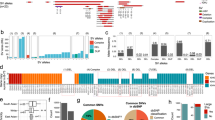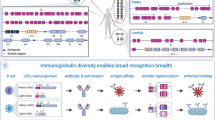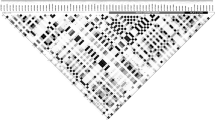Abstract
Immunoglobulins are the effector molecules of the adaptive humoral immune system. In a genome-wide association study of 19,219 individuals, we found 38 new variants and replicated 5 known variants associating with IgA, IgG or IgM levels or with composite immunoglobulin traits, accounted for by 32 loci. Variants at these loci also affect the risk of autoimmune diseases and blood malignancies and influence blood cell development. Notable associations include a rare variant at RUNX3 decreasing IgA levels by shifting isoform proportions (rs188468174[C>T]: P = 8.3 × 10−55, β = −0.90 s.d.), a rare in-frame deletion in FCGR2B abolishing IgG binding to the encoded receptor (p.Asn106del: P = 4.2 × 10−8, β = 1.03 s.d.), four IGH locus variants influencing class switching, and ten new associations with the HLA region. Our results provide new insight into the regulation of humoral immunity.
This is a preview of subscription content, access via your institution
Access options
Access Nature and 54 other Nature Portfolio journals
Get Nature+, our best-value online-access subscription
$29.99 / 30 days
cancel any time
Subscribe to this journal
Receive 12 print issues and online access
$209.00 per year
only $17.42 per issue
Buy this article
- Purchase on Springer Link
- Instant access to full article PDF
Prices may be subject to local taxes which are calculated during checkout




Similar content being viewed by others
References
Stavnezer, J., Guikema, J.E. & Schrader, C.E. Mechanism and regulation of class switch recombination. Annu. Rev. Immunol. 26, 261–292 (2008).
Yoshida, T. et al. Memory B and memory plasma cells. Immunol. Rev. 237, 117–139 (2010).
Vincent, F.B., Morand, E.F., Schneider, P. & Mackay, F. The BAFF/APRIL system in SLE pathogenesis. Nat. Rev. Rheumatol. 10, 365–373 (2014).
Bronson, P.G. et al. Common variants at PVT1, ATG13–AMBRA1, AHI1 and CLEC16A are associated with selective IgA deficiency. Nat. Genet. 48, 1425–1429 (2016).
Keller, M.D. et al. Mutation in IRF2BP2 is responsible for a familial form of common variable immunodeficiency disorder. J. Allergy Clin. Immunol. 138, 544–550 (2016).
Orange, J.S. et al. Genome-wide association identifies diverse causes of common variable immunodeficiency. J. Allergy Clin. Immunol. 127, 1360–1367 (2011).
Swaminathan, B. et al. Variants in ELL2 influencing immunoglobulin levels associate with multiple myeloma. Nat. Commun. 6, 7213 (2015).
Viktorin, A. et al. IgA measurements in over 12 000 Swedish twins reveal sex differential heritability and regulatory locus near CD30L. Hum. Mol. Genet. 23, 4177–4184 (2014).
Yang, C. et al. Genome-wide association study identifies TNFSF13 as a susceptibility gene for IgA in a South Chinese population in smokers. Immunogenetics 64, 747–753 (2012).
Yang, M. et al. Genome-wide scan identifies variant in TNFSF13 associated with serum IgM in a healthy Chinese male population. PLoS One 7, e47990 (2012).
Liao, M. et al. Genome-wide association study identifies common variants at TNFRSF13B associated with IgG level in a healthy Chinese male population. Genes Immun. 13, 509–513 (2012).
Granada, M. et al. A genome-wide association study of plasma total IgE concentrations in the Framingham Heart Study. J. Allergy Clin. Immunol. 129, 840–845 (2012).
Weidinger, S. et al. Genome-wide scan on total serum IgE levels identifies FCER1A as novel susceptibility locus. PLoS Genet. 4, e1000166 (2008).
Moffatt, M.F. et al. A large-scale, consortium-based genomewide association study of asthma. N. Engl. J. Med. 363, 1211–1221 (2010).
Matthews, A.J., Zheng, S., DiMenna, L.J. & Chaudhuri, J. Regulation of immunoglobulin class-switch recombination: choreography of noncoding transcription, targeted DNA deamination, and long-range DNA repair. Adv. Immunol. 122, 1–57 (2014).
Sveinbjornsson, G. et al. Weighting sequence variants based on their annotation increases power of whole-genome association studies. Nat. Genet. 48, 314–317 (2016).
Emilsson, V. et al. Genetics of gene expression and its effect on disease. Nature 452, 423–428 (2008).
Westra, H.J. et al. Systematic identification of trans eQTLs as putative drivers of known disease associations. Nat. Genet. 45, 1238–1243 (2013).
Carithers, L.J. et al. A novel approach to high-quality postmortem tissue procurement: the GTEx Project. Biopreserv. Biobank. 13, 311–319 (2015).
Lappalainen, T. et al. Transcriptome and genome sequencing uncovers functional variation in humans. Nature 501, 506–511 (2013).
Köhler, S. et al. Construction and accessibility of a cross-species phenotype ontology along with gene annotations for biomedical research. F1000Res. 2, 30 (2013).
Eppig, J.T., Blake, J.A., Bult, C.J., Kadin, J.A. & Richardson, J.E. The Mouse Genome Database (MGD): facilitating mouse as a model for human biology and disease. Nucleic Acids Res. 43, D726–D736 (2015).
Amberger, J.S., Bocchini, C.A., Schiettecatte, F., Scott, A.F. & Hamosh, A. OMIM.org: Online Mendelian Inheritance in Man (OMIM®), an online catalog of human genes and genetic disorders. Nucleic Acids Res. 43, D789–D798 (2015).
Bossen, C. & Schneider, P. BAFF, APRIL and their receptors: structure, function and signaling. Semin. Immunol. 18, 263–275 (2006).
Chenery, A. et al. The retinoic acid–metabolizing enzyme Cyp26b1 regulates CD4 T cell differentiation and function. PLoS One 8, e72308 (2013).
Takeuchi, H., Yokota, A., Ohoka, Y. & Iwata, M. Cyp26b1 regulates retinoic acid–dependent signals in T cells and its expression is inhibited by transforming growth factor-β. PLoS One 6, e16089 (2011).
Capasso, M. Regulation of immune responses by proton channels. Immunology 143, 131–137 (2014).
Wang, J.H. et al. Aiolos regulates B cell activation and maturation to effector state. Immunity 9, 543–553 (1998).
Ma, S., Pathak, S., Trinh, L. & Lu, R. Interferon regulatory factors 4 and 8 induce the expression of Ikaros and Aiolos to down-regulate pre-B-cell receptor and promote cell-cycle withdrawal in pre-B-cell development. Blood 111, 1396–1403 (2008).
Merluzzi, S. et al. Mast cells enhance proliferation of B lymphocytes and drive their differentiation toward IgA-secreting plasma cells. Blood 115, 2810–2817 (2010).
Carotta, S. et al. The transcription factors IRF8 and PU.1 negatively regulate plasma cell differentiation. J. Exp. Med. 211, 2169–2181 (2014).
Costantino, C.M., Hang, H.C., Kent, S.C., Hafler, D.A. & Ploegh, H.L. Lysosomal cysteine and aspartic proteases are heterogeneously expressed and act redundantly to initiate human invariant chain degradation. J. Immunol. 180, 2876–2885 (2008).
Lin, S.C., Wortis, H.H. & Stavnezer, J. The ability of CD40L, but not lipopolysaccharide, to initiate immunoglobulin switching to immunoglobulin G1 is explained by differential induction of NF-κB/Rel proteins. Mol. Cell. Biol. 18, 5523–5532 (1998).
Ramachandran, S. et al. The RNF8/RNF168 ubiquitin ligase cascade facilitates class switch recombination. Proc. Natl. Acad. Sci. USA 107, 809–814 (2010).
Cerutti, A. et al. Engagement of CD153 (CD30 ligand) by CD30+ T cells inhibits class switch DNA recombination and antibody production in human IgD+ IgM+ B cells. J. Immunol. 165, 786–794 (2000).
Yi, Z., Lin, W.W., Stunz, L.L. & Bishop, G.A. Roles for TNF-receptor associated factor 3 (TRAF3) in lymphocyte functions. Cytokine Growth Factor Rev. 25, 147–156 (2014).
Welter, D. et al. The NHGRI GWAS Catalog, a curated resource of SNP–trait associations. Nucleic Acids Res. 42, D1001–D1006 (2014).
Pan-Hammarström, Q. et al. Reexamining the role of TACI coding variants in common variable immunodeficiency and selective IgA deficiency. Nat. Genet. 39, 429–430 (2007).
Ramirez-Alejo, N. & Santos-Argumedo, L. Innate defects of the IL-12/IFN-γ axis in susceptibility to infections by mycobacteria and Salmonella. J. Interferon Cytokine Res. 34, 307–317 (2014).
Hambleton, S. et al. IRF8 mutations and human dendritic-cell immunodeficiency. N. Engl. J. Med. 365, 127–138 (2011).
Stewart, G.S. et al. The RIDDLE syndrome protein mediates a ubiquitin-dependent signaling cascade at sites of DNA damage. Cell 136, 420–434 (2009).
Negro, R. et al. Overexpression of the autoimmunity-associated phosphatase PTPN22 promotes survival of antigen-stimulated CLL cells by selectively activating AKT. Blood 119, 6278–6287 (2012).
Rinaldi, A. et al. Genome-wide DNA profiling better defines the prognosis of chronic lymphocytic leukaemia. Br. J. Haematol. 154, 590–599 (2011).
Deambrogi, C. et al. Analysis of the REL, BCL11A, and MYCN proto-oncogenes belonging to the 2p amplicon in chronic lymphocytic leukemia. Am. J. Hematol. 85, 541–544 (2010).
Estécio, M.R. et al. RUNX3 promoter hypermethylation is frequent in leukaemia cell lines and associated with acute myeloid leukaemia inv(16) subtype. Br. J. Haematol. 169, 344–351 (2015).
Cameron, E.R. & Neil, J.C. The Runx genes: lineage-specific oncogenes and tumor suppressors. Oncogene 23, 4308–4314 (2004).
Roberts, K.G. et al. Genetic alterations activating kinase and cytokine receptor signaling in high-risk acute lymphoblastic leukemia. Cancer Cell 22, 153–166 (2012).
Novershtern, N. et al. Densely interconnected transcriptional circuits control cell states in human hematopoiesis. Cell 144, 296–309 (2011).
Boyd, K.D. et al. Mapping of chromosome 1p deletions in myeloma identifies FAM46C at 1p12 and CDKN2C at 1p32.3 as being genes in regions associated with adverse survival. Clin. Cancer Res. 17, 7776–7784 (2011).
Broyl, A. et al. Gene expression profiling for molecular classification of multiple myeloma in newly diagnosed patients. Blood 116, 2543–2553 (2010).
Chapman, M.A. et al. Initial genome sequencing and analysis of multiple myeloma. Nature 471, 467–472 (2011).
Zhan, F. et al. Gene-expression signature of benign monoclonal gammopathy evident in multiple myeloma is linked to good prognosis. Blood 109, 1692–1700 (2007).
Corces, M.R. et al. Lineage-specific and single-cell chromatin accessibility charts human hematopoiesis and leukemia evolution. Nat. Genet. 48, 1193–1203 (2016).
Bangsow, C. et al. The RUNX3 gene—sequence, structure and regulated expression. Gene 279, 221–232 (2001).
Watanabe, K. et al. Requirement for Runx proteins in IgA class switching acting downstream of TGF-β1 and retinoic acid signaling. J. Immunol. 184, 2785–2792 (2010).
Chung, D.D., Honda, K., Cafuir, L., McDuffie, M. & Wotton, D. The Runx3 distal transcript encodes an additional transcriptional activation domain. FEBS J. 274, 3429–3439 (2007).
Kheradpour, P. & Kellis, M. Systematic discovery and characterization of regulatory motifs in ENCODE TF binding experiments. Nucleic Acids Res. 42, 2976–2987 (2014).
Kersten, S., Reczek, P.R. & Noy, N. The tetramerization region of the retinoid X receptor is important for transcriptional activation by the receptor. J. Biol. Chem. 272, 29759–29768 (1997).
Seo, G.Y. et al. Retinoic acid acts as a selective human IgA switch factor. Hum. Immunol. 75, 923–929 (2014).
Okada, Y. et al. Genetics of rheumatoid arthritis contributes to biology and drug discovery. Nature 506, 376–381 (2014).
Jostins, L. et al. Host–microbe interactions have shaped the genetic architecture of inflammatory bowel disease. Nature 491, 119–124 (2012).
Gudbjartsson, D.F. et al. Sequence variants affecting eosinophil numbers associate with asthma and myocardial infarction. Nat. Genet. 41, 342–347 (2009).
Hester, A.G. et al. Relationship between a common variant in the fatty acid desaturase (FADS) cluster and eicosanoid generation in humans. J. Biol. Chem. 289, 22482–22489 (2014).
Joshi, H.J. & Gupta, R. Eukaryotic glycosylation: online methods for site prediction on protein sequences. Methods Mol. Biol. 1273, 127–137 (2015).
Hogarth, P.M. & Pietersz, G.A. Fc receptor-targeted therapies for the treatment of inflammation, cancer and beyond. Nat. Rev. Drug Discov. 11, 311–331 (2012).
de Lau, W. et al. Lgr5 homologues associate with Wnt receptors and mediate R-spondin signalling. Nature 476, 293–297 (2011).
Bruhns, P. et al. Specificity and affinity of human Fcγ receptors and their polymorphic variants for human IgG subclasses. Blood 113, 3716–3725 (2009).
Nimmerjahn, F., Gordan, S. & Lux, A. FcγR dependent mechanisms of cytotoxic, agonistic, and neutralizing antibody activities. Trends Immunol. 36, 325–336 (2015).
Papadakis, K.A. et al. Krüppel-like factor KLF10 regulates transforming growth factor receptor II expression and TGF-β signaling in CD8+ T lymphocytes. Am. J. Physiol. Cell Physiol. 308, C362–C371 (2015).
McKarns, S.C., Letterio, J.J. & Kaminski, N.E. Concentration-dependent bifunctional effect of TGF-β1 on immunoglobulin production: a role for Smad3 in IgA production in vitro. Int. Immunopharmacol. 3, 1761–1774 (2003).
Arechiga, A.F. et al. Cutting edge: the PTPN22 allelic variant associated with autoimmunity impairs B cell signaling. J. Immunol. 182, 3343–3347 (2009).
Oetke, C., Vinson, M.C., Jones, C. & Crocker, P.R. Sialoadhesin-deficient mice exhibit subtle changes in B- and T-cell populations and reduced immunoglobulin M levels. Mol. Cell. Biol. 26, 1549–1557 (2006).
Benson, M.J. et al. Cutting edge: the dependence of plasma cells and independence of memory B cells on BAFF and APRIL. J. Immunol. 180, 3655–3659 (2008).
Jabara, H.H., Weng, Y., Sannikova, T. & Geha, R.S. TRAF2 and TRAF3 independently mediate Ig class switching driven by CD40. Int. Immunol. 21, 477–488 (2009).
Ben-Ali, M. et al. Functional characterization of naturally occurring genetic variants in the human TLR1-2-6 gene family. Hum. Mutat. 32, 643–652 (2011).
Johnson, C.M. et al. Cutting edge: a common polymorphism impairs cell surface trafficking and functional responses of TLR1 but protects against leprosy. J. Immunol. 178, 7520–7524 (2007).
Lin, W.W., Hostager, B.S. & Bishop, G.A. TRAF3, ubiquitination, and B-lymphocyte regulation. Immunol. Rev. 266, 46–55 (2015).
Ohtsubo, T. et al. Identification of human MutY homolog (hMYH) as a repair enzyme for 2-hydroxyadenine in DNA and detection of multiple forms of hMYH located in nuclei and mitochondria. Nucleic Acids Res. 28, 1355–1364 (2000).
Yousif, A.S., Stanlie, A., Begum, N.A. & Honjo, T. Opinion: uracil DNA glycosylase (UNG) plays distinct and non-canonical roles in somatic hypermutation and class switch recombination. Int. Immunol. 26, 575–578 (2014).
Rölle, A. et al. IL-12-producing monocytes and HLA-E control HCMV-driven NKG2C+ NK cell expansion. J. Clin. Invest. 124, 5305–5316 (2014).
Zhang, Y., Fear, D.J., Willis-Owen, S.A., Cookson, W.O. & Moffatt, M.F. Global gene regulation during activation of immunoglobulin class switching in human B cells. Sci. Rep. 6, 37988 (2016).
Frankowiack, M. et al. The higher frequency of IgA deficiency among Swedish twins is not explained by HLA haplotypes. Genes Immun. 16, 199–205 (2015).
Caffrey, M.F. & James, D.C. Human lymphocyte antigen association in ankylosing spondylitis. Nature 242, 121 (1973).
Brown, M.A., Kenna, T. & Wordsworth, B.P. Genetics of ankylosing spondylitis—insights into pathogenesis. Nat. Rev. Rheumatol. 12, 81–91 (2016).
Kenna, T.J., Hanson, A., Costello, M.E. & Brown, M.A. Functional genomics and its bench-to-bedside translation pertaining to the identified susceptibility alleles and loci in ankylosing spondylitis. Curr. Rheumatol. Rep. 18, 63 (2016).
Delaneau, O., Howie, B., Cox, A.J., Zagury, J.F. & Marchini, J. Haplotype estimation using sequencing reads. Am. J. Hum. Genet. 93, 687–696 (2013).
Howie, B.N., Donnelly, P. & Marchini, J. A flexible and accurate genotype imputation method for the next generation of genome-wide association studies. PLoS Genet. 5, e1000529 (2009).
Auton, A. et al. A global reference for human genetic variation. Nature 526, 68–74 (2015).
Alexander, D.H., Novembre, J. & Lange, K. Fast model-based estimation of ancestry in unrelated individuals. Genome Res. 19, 1655–1664 (2009).
Price, A.L. et al. Principal components analysis corrects for stratification in genome-wide association studies. Nat. Genet. 38, 904–909 (2006).
Benonisdottir, S. et al. Epigenetic and genetic components of height regulation. Nat. Commun. 7, 13490 (2016).
Gudbjartsson, D.F. et al. Large-scale whole-genome sequencing of the Icelandic population. Nat. Genet. 47, 435–444 (2015).
Kong, A. et al. Detection of sharing by descent, long-range phasing and haplotype imputation. Nat. Genet. 40, 1068–1075 (2008).
Styrkarsdottir, U. et al. Nonsense mutation in the LGR4 gene is associated with several human diseases and other traits. Nature 497, 517–520 (2013).
Sveinbjornsson, G. et al. HLA class II sequence variants influence tuberculosis risk in populations of European ancestry. Nat. Genet. 48, 318–322 (2016).
McLaren, W. et al. Deriving the consequences of genomic variants with the Ensembl API and SNP Effect Predictor. Bioinformatics 26, 2069–2070 (2010).
Flicek, P. et al. Ensembl 2012. Nucleic Acids Res. 40, D84–D90 (2012).
Pruitt, K.D., Tatusova, T., Brown, G.R. & Maglott, D.R. NCBI Reference Sequences (RefSeq): current status, new features and genome annotation policy. Nucleic Acids Res. 40, D130–D135 (2012).
Bulik-Sullivan, B.K. et al. LD Score regression distinguishes confounding from polygenicity in genome-wide association studies. Nat. Genet. 47, 291–295 (2015).
Rao, S.S. et al. A 3D map of the human genome at kilobase resolution reveals principles of chromatin looping. Cell 159, 1665–1680 (2014).
Kundaje, A. et al. Integrative analysis of 111 reference human epigenomes. Nature 518, 317–330 (2015).
ENCODE Project Consortium. An integrated encyclopedia of DNA elements in the human genome. Nature 489, 57–74 (2012).
Acknowledgements
We thank all study participants and the staff at the Icelandic Patient Recruitment Center and the deCODE genetics core facilities. We are indebted to the blood donors and staff at Lundatappen who participated in the project.
This work was supported by research grants from the Swedish Foundation for Strategic Research (KF10-0009, B.N.), the Marianne and Marcus Wallenberg Foundation (2010.0112, B.N.), the Knut and Alice Wallenberg Foundation (2012.0193, B.N.) and the Swedish Research Council (2012-1753, B.N.).
Author information
Authors and Affiliations
Contributions
S.J., D.F.G., U.T., I.J., B.N. and K.S. coordinated and designed the study. G.I.E., B.R.L., I.O., O.S., H.H. and I.J. coordinated and managed collection of samples and ascertainment of phenotype data in Iceland. A.L.d.L.P., E.E., E.J., R.A., U.G., M.H. and Å.J. collected samples and phenotype data in Sweden. S.J., G.Th., B.V.H., S.A.G., A.G., A.S., L.S., A.O., S.O., A.L.d.L.P., B.S., M.A., G.S., G.M., P.S., D.F.G., A.-K.W., I.J. and B.N. carried out statistical and bioinformatic analyses of genetic data. A.L.d.L.P., B.S., E.E., A.J., G.V., R.P., M.W., A.E.H.B. and G.D. carried out functional experiments and analysis. S.J., A.-K.W., I.J., B.N. and K.S. drafted the manuscript. All authors contributed to the final manuscript.
Corresponding authors
Ethics declarations
Competing interests
S.J., G.S., S.A.G., A.G., B.V.H., H.H., A.J., A.O., S.O., A.S., L.S., G.M., P.S., G.Th., D.F.G., U.T., I.J. and K.S. are employees of deCODE Genetics/Amgen, Inc.
Supplementary information
Supplementary Text and Figures
Supplementary Figures 1–8, Supplementary Tables 1–4, 6–10, 12, 14–17 and 20, and Supplementary Note (PDF 6796 kb)
Supplementary Table 5
Association of the 43 novel and confirmed immunoglobulin variants with each of the nine immunoglobulin traits in the Icelandic data. (XLSX 27 kb)
Supplementary Table 11
Immune-related mouse phenotypes for 310 immunoglobulin locus genes. (XLSX 21 kb)
Supplementary Table 13
Association of 43 immunoglobulin lead SNPs with frequencies of eight B cell populations in peripheral blood from healthy Swedish individuals. (XLSX 27 kb)
Supplementary Table 18
Correlation (linkage disequilibrium, r2) matrix of classical HLA alleles and SNPs in the HLA region with significant association with one or more immunoglobulin traits in Iceland. (XLSX 19 kb)
Supplementary Table 19
Meta-analysis results for immunoglobulin traits showing all variants with combined P value below 1 × 10−6. (XLSX 2978 kb)
Supplementary Table 21
The basis for selection of candidate genes. (XLSX 20 kb)
Supplementary Table 22
Genes overlapping the defined locus region at novel and previously reported immunoglobulin-associated loci. (XLSX 23 kb)
Rights and permissions
About this article
Cite this article
Jonsson, S., Sveinbjornsson, G., de Lapuente Portilla, A. et al. Identification of sequence variants influencing immunoglobulin levels. Nat Genet 49, 1182–1191 (2017). https://doi.org/10.1038/ng.3897
Received:
Accepted:
Published:
Issue Date:
DOI: https://doi.org/10.1038/ng.3897



